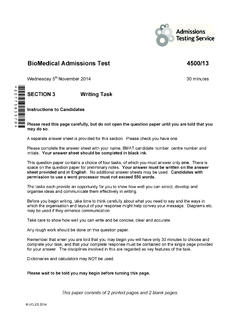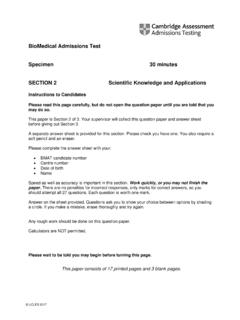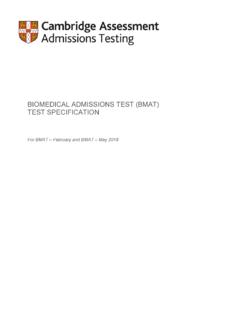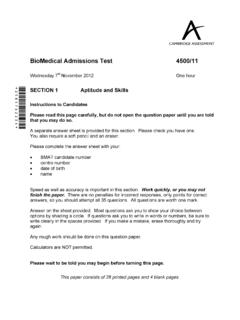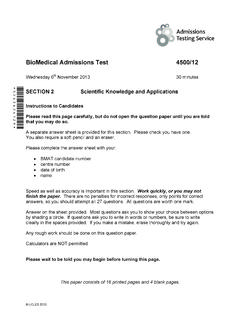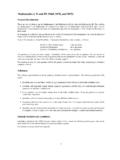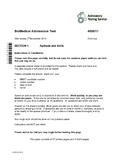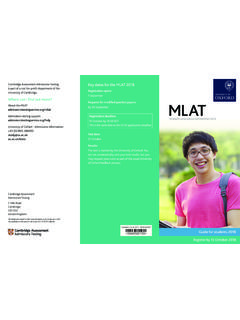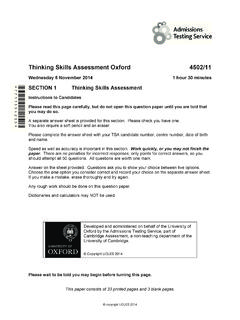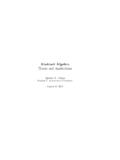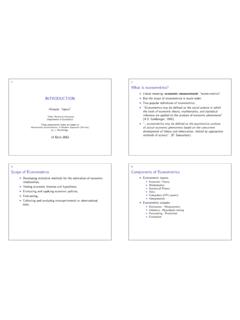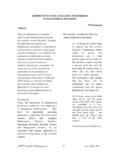Transcription of BMAT test specification 2018 - admissionstesting.org
1 BIOMEDICAL ADMISSIONS TEST (BMAT) TEST specification For BMAT February and BMAT May 2019 1 BioMedical Admissions Test (BMAT) test specification Purpose of the test The purpose of the BioMedical Admissions Test is solely to provide an assessment of candidate s po ten tial in an academically demanding u nde rgra dua te b iomedical d egree, and not their fitne ss to practise m edicine or d entistry which universitie s will continue to assess in other ways. The test results a re in tended to be used as a significant component of the selection decision in conjunction with other inform ation available to admissions tuto rs.
2 Test items draw upon generic academic skills and basic science knowledge, rather than recent specia list tea chi ng, and provide an objective basis for comparing cand idates from differ ent backgrounds, includ ing m atu re applicants and tho se from differ ent countries. The test is desi gned to be challenging, in order to discriminat e effectively b etween able applica nts for university courses, includ ing tho se who may have achieved the hi ghe st possible gra des in school examinat ions. Qualities to be assessed Knowledge Familiarity w ith concepts, terms and propositional knowledge typically covered by non-spec ialist secondary school cou rses in Science and Mathe mati cs.
3 Skills Handling of number and communication , specifically: ability to read formal Eng lish and follow writte n instruction s; ability to work quickly and accurate ly; ability to perform very simple m enta l ari thmeti c; ability to iden tify the straightforward m eaning of particu lar phrases within a longer text; ability to extract the mean ing intended by an aut hor, w here to do so requires more than one syntactical elem ent of the text to be understood and synthe sised; ability to read simple quanti tat ive data presente d numerically or graphically and to unde rstand their str aightfo rward mean ing and to be able to produ ce simple and appropriat e gr aphs or diagrams of quan titative dat a; abi lity to generalise from quantitative data, for example to i nterpret a trend, a p att ern, or a rate and to be able to apply the generalisation to the particular or hypotheti cal context.
4 Ability to make logical infer ences or deducti ons from textual inform atio n and quanti tative data and to id entify il logical inferences; ability to communicat e k nowled ge, unders tan ding, interpr etat ion, infer ences, argument s, deductions and pr edi ction s by the app ropri ate use of clear and concise written English and diag rams; a tenden cy to take app roaches that a re critical, evidence-based, and which consider alternatives. 2 Structure of the t est The test has three e lement s: a 60-m inut e test of Aptitude and Skills, a 30-m inut e test of Scientific Knowledge and Applications and a 30-m inut e Wr iting Task.
5 The structure of each of the se three elements is out lined b elow. Example test pa pers a re available at 1: A ptit ude and Skills This element tes ts generic ski lls often ut ilised in und ergr adua te st udy . T he range of th ese and t he a ppro xim ate balance between them in t erms of t he time and number of marks which w ill be availa ble is out lined below. Q uest ions w ill be in multiple-ch oice format . Calculators m ay no t be us ed. Minutes Number of ques tio ns Problem Solving 30 13 demands insight to determine how to encode and process numerical information (approx) so as to solve problems, using simple numerical and algebraic operations.
6 Problem solving will require the capacity to: select relevant information 3 7 recognise analogous cases 3 7 determine and apply appropriate procedures 3 7 Understanding Argument 15 10 presents a series of logical arguments and requires respondents to: (approx) identify reasons, assumptions and conclusions 2 4 detect flaws 2 4 draw conclusions 2 4 Data Analysis & Inference 15 12 demands the use of information skills (vocabulary, comprehension, basic (approx) descriptive statistics and graphical tools), data interpretation, analysis and scientific inference and deduction to reach appropriate conclusions from information provided in different forms, namely: textual 3 5 statistical 3 5 graphical 3 5 Total 60 35 2.
7 Scie ntif ic Knowledge and Applicati ons This element tes ts w hether candidates have the core knowledge and the capac ity to app ly it, w hich is a pre-requisite for h igh -level stu dy in biomedical sciences . Questi ons w ill be restricted to m ate rial ty pica lly incl uded in n on-specialist sc hool Science and Mathematics courses. They w ill however require a level of understanding appropr iate for such an able target g roup. T he balance between the s ubject are as in terms of t ime and m arks available is o utlined below.
8 Questi ons w ill be in m ultiple-c hoi ce form at. Calculators m ay not be used. Minutes Number of ques tio ns Biology 8 (approx) 6 8 Chemistry 8 (approx) 6 8 Physics 8 (approx) 6 8 Mathematics 6 (approx) 5 7 Total 30 27 For the Section 2 content specification , see page 4 of this document Appendix BMAT Section 2: Assumed Subject Knowledge. 3 3: Writing Task A selection of tasks will be available, f rom w hich one must be chosen. T hese will incl ude brie f quest ions based on topics of gen era l, medical or sc ien tific interes t. Questi ons w ill pro vide a short proposition and may req uire c andidates to: ex plain or discuss the proposition 's implications; suggest a coun ter pr opos ition or argument; suggest a (meth od for) resolu ti on.
9 The Writing Task pro vides an opportunity for candi dat es to demonstrate t he capac ity to consider diff erent aspects of a proposition, a nd to communicate t hem effe ctively in writing. Skil ls to be a ssessed include those concerning communicati on, d escr ibed a bove. All specified skills m ay be assessed. The question paper will brief c andidates about the natu re and purpose of t he task. They w ill be re quired to produce a written communicat ion, w ithout the assistanc e of a dict ionary or au toma ted s pelling and grammar-checking s oftw are.
10 W hil st th ey may make prel imi nary notes, t he fi nal prod uct is s tric tly limited to o ne A4 pag e, to promote the disciplined s electi on and organisat ion of i deas , together with their concise, accurate and effec tive expressio n. When scoring responses , cons ider ati on w ill be given to t he degree to w hich cand ida tes hav e: a ddr essed the question in the way dem anded; organis ed their thoughts cl earl y; expressed themselves usi ng concise, compelli ng a nd c orr ec t English; used their gene ral knowledge and opinions app ropr iatel y.
